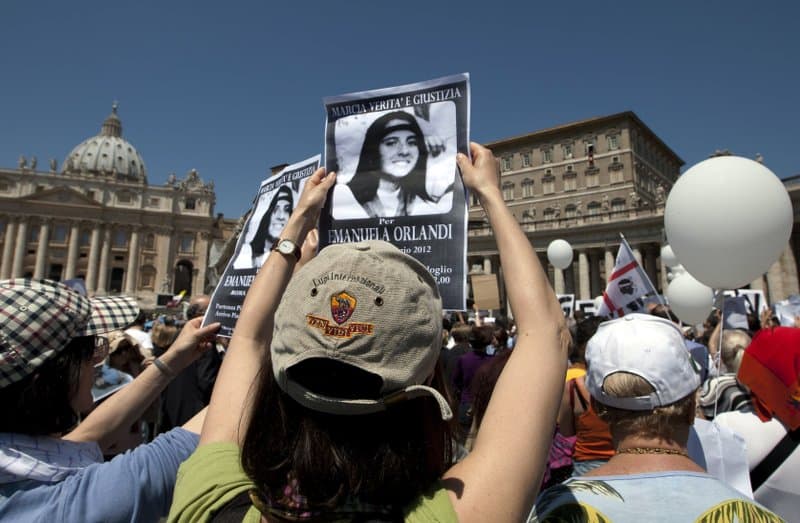ROME – On the anniversary of the disappearance of Italian teen Emanuela Orlandi – which is perhaps Italy’s most famous unsolved mystery – her brother has criticized Pope Francis’s handling of the case ahead of his annual sit-in at the Vatican, saying the pope is not doing enough.
Emanuela Orlandi was just 15 when she disappeared on her way home from a music lesson on June 22, 1983. Her still-unsolved disappearance 38 years later has become one of Italy’s most infamous unsolved mysteries, with numerous conspiracy theories developing over the years.
Since the Orlandi family were citizens of the Vatican at the time Emanuela disappeared – her father Ercole was working as a clerk in the Prefecture of the papal household – many of those theories involve the Vatican.
Speaking to Italian newspaper Nuova Società, Emanuela’s brother, Pietro Orlandi, criticized Pope Francis’s attitude toward his sister’s case, saying, “Bergoglio has raised the wall around this story even more than his predecessors and demonstrates a total closure toward Emanuela and her kidnapping.”
“The pope certainly knows and could dispel many doubts, but he has no intention of doing so,” Orlandi said, insisting that despite Francis’s “decision-making” approach to Vatican reform, he and other top Vatican officials “will unfortunately continue to do everything to prevent the truth from getting out, but in the end, they will give in, and the truth will come out.”
Over the years, some have speculated Emanuela was kidnapped by the Italian mob in a bid to pressure the Vatican bank, while others believe she might have fallen victim to a clerical sex ring, and still others have suggested she was taken by Turkish nationalists in order to strongarm Pope John Paul II into releasing the man who attempted to assassinate him in 1981, Mehmet Ali Agca.
Vatican officials have continually insisted that they’ve handed over everything they know, and that there’s no secret archive or other evidence in their possession with hidden information. They’ve also repeatedly pledged their cooperation with reasonable efforts to bring closure to the case.
Orlandi himself, who after his sister’s disappearance went on to become not only an advocate for others in his situation but a popular host of the weekly TV program, Scomparsi (“The Disappeared”) on Italy’s Sky satellite television – has never been satisfied with this answer and has continued to press the Vatican to do more, conducting annual “sit-ins” at the Vatican on the anniversary of his sister’s disappearance.
In October 2018 it seemed like there might finally be a break in the case when fragments of human bones were found during the renovation of a building attached to the Vatican’s embassy to Italy.
Initial tests showed that the bones belonged to a woman, raising hopes that Emanuela’s disappearance and that of another Italian teen who disappeared the same year, Mirella Gregori, might finally be solved. However, further testing revealed that the bones dated further back than the 1980s, and thus did not belong to either Emanuela or Gregori.
In 2019, acting on a request from the Orlandi family, who said they had received an anonymous tip involving the whereabouts of Emanuela’s remains, Vatican authorities opened two tombs in the Teutonic Cemetery on its grounds.
Although the remains of two princesses who were supposed to be buried there were nowhere to be found, investigators did discover two ossuaries containing 26 bags with what they called “thousands” of bones, likely belonging to “dozens” of people.
Scientists conducting testing of the bones announced after a few months that they were more than a century old, thus not those of Orlandi, meaning the truth about what really happened to Emanuela and where she might be is still a mystery.
In his interview with Nuova Società, Orlandi said he does not believe his sister’s case holds any ties to the late American Archbishop Paul Marcinkus, president of the Vatican Bank from 1971-1989, as some have suggested, saying he knew Marcinkus well and met with him often over the years.
Orlandi also hesitated to voice an opinion about possible ties between Emanuela’s disappearance and the assassination attempt on John Paul II’s life, saying, “we are always in the field of hypotheses, because no one can say how things stand since no one has ever emerged in favor of one hypothesis or another.”
“Sometimes there is too much rush when a clue is found to make it public immediately without a minimum of verification,” he said.
Asked whether he believes there is still someone inside the Vatican who holds answers to his sister’s case and who might want to talk, Olandi said that “if there is some grey-haired man in the Vatican determined to free his conscience, so be it, I’m certainly ready to listen to him.”
“Rest assured that if he were a person in good faith and willing to help, he would contact the relatives in confidence,” Orlandi said. However, “if he wants to remove the truth, sidetrack it, or create confusion, he’ll go to a journalist because that’s the only way that news can be more widely disseminated.”
In terms of what he expects from this year’s sit-in at the Vatican, Orlandi said that while some are calling the move “useless and obsolete” given the amount of time that has passed since his sister disappeared, “it is important because it hurts many people, and the more people present the more it will hurt, because each additional person is a brick of that wall of silence, which will be removed.”
“For this, I hope that many people will come,” he said, adding, “I am fierce and ready to remind everyone of the misdeeds of so many hypocrites, inside and outside of the Vatican, who over many years have concealed and continue to conceal the truth.”
Follow Elise Ann Allen on Twitter: @eliseannallen














